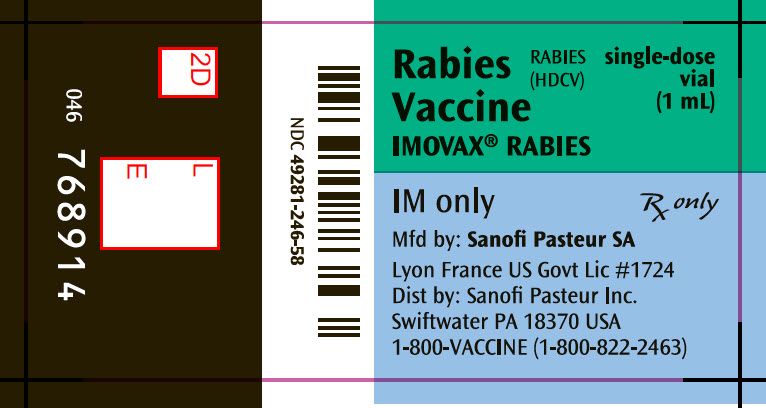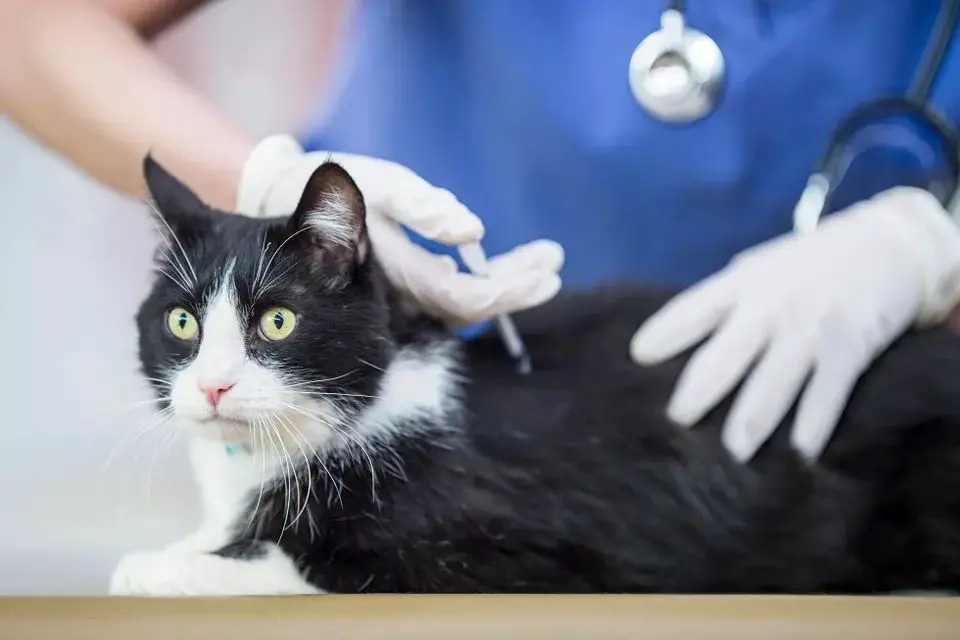What is Rabies?
Rabies is an acute viral disease that causes inflammation of the brain in humans and other mammals. It is caused by RNA viruses in the family Rhabdoviridae, genus Lyssavirus (https://www.cdc.gov/rabies/about.html). The rabies virus is transmitted through the saliva of infected animals and attacks the central nervous system.
Once symptoms appear, rabies is almost always fatal. However, it can be prevented if treatment is administered shortly after exposure, before symptoms develop. According to the CDC, rabies causes tens of thousands of deaths worldwide every year. Dogs are the main source of human rabies deaths, contributing up to 99% of all rabies transmissions to humans (https://www.who.int/news-room/fact-sheets/detail/rabies).
Rabies can infect all warm-blooded animals, including pets like cats and dogs. Wildlife like raccoons, skunks, bats, and foxes are also common carriers. When an unvaccinated person is bitten, scratched, or exposed to the saliva or nervous tissue from an infected animal, the rabies virus can be transmitted.
Can Cats Transmit Rabies?
Yes, domestic cats can transmit rabies. Cats are one of the most common transmitters of rabies in the United States, according to the CDC (https://www.cdc.gov/rabies/exposure/animals/cats.html). While any warm-blooded mammal can get rabies, cats pose a high risk because of their close interactions with humans.
Stray and feral cats are more likely to be infected with rabies than house cats that live indoors. Stray cats spend more time outdoors hunting wildlife, which increases their risk of exposure. According to the CDC, about 4-5% of stray cats are found to be rabid in areas where rabies is common. House cats kept indoors have a lower risk of exposure.
However, even an indoor cat can get rabies if exposed to a rabid animal that gets into the home. That’s why it’s important to vaccinate all cats against rabies and supervise their time outdoors.
How is Rabies Transmitted by Cats?
Rabies is transmitted through the bite of an infected animal. Specifically, rabies transmission occurs when the virus present in the rabid animal’s saliva enters the body of another animal or person through broken skin or mucous membranes from a bite that breaks the skin. The rabies virus travels through nerves up to the brain where it causes inflammation and dysfunction.

Scratches from cats, even deep scratches that break the skin, do not pose a high risk for rabies transmission. The rabies virus is concentrated in the saliva, so a bite that introduces infected saliva into the wound is required for transmission. Scratches generally do not introduce enough infected saliva for the rabies virus to enter the body in a sufficient amount.
According to the Centers for Disease Control and Prevention, nibbling and superficial scratches from cats almost never transmit rabies. However, it is possible, though rare, for scratches that cause bleeding with viral material present to transmit rabies 1.
In summary, rabies transmission from cats occurs through their bite, specifically when the bite breaks the skin and introduces virus-containing saliva into the wound. Scratches alone are very unlikely to transmit rabies.
What Are the Signs of Rabies in Cats?
Rabies causes dramatic behavior changes in cats as the virus attacks the central nervous system. According to the Merck Veterinary Manual, the most reliable rabies symptoms are sudden and severe behavioral changes and unexplained paralysis. Aggressive behavior is one of the most common symptoms of rabies in cats. Rabies causes inflammation of the cat’s brain, which results in a change in temperament, irritability, and aggressiveness, even in cats who are normally friendly and docile (Merck Veterinary Manual).
Excessive drooling and difficulty swallowing are also common rabies symptoms. As the Merck Veterinary Manual explains, muscle spasms in the throat prevent the cat from swallowing, leading to excessive drooling. Cats may drool continuously and may not be able to swallow their own saliva. According to VCA Hospitals, the third stage of rabies involves partial paralysis, abnormal behavior, and excessive salivation.
Other symptoms of rabies in cats include restlessness, excitability, muscle tremors, paralysis in later stages, and seizures. Generally, a rabid cat’s health will deteriorate rapidly once symptoms start. Rabies is almost always fatal in animals if left untreated, with death occurring within 10 days from the onset of symptoms (VCA Hospitals).
Should I Be Concerned About a Cat Bite?
Any bite that breaks the skin should be evaluated by a doctor as soon as possible. According to the VCA Animal Hospitals, cat bites often appear small or innocuous but can cause serious infections without proper medical care (https://vcahospitals.com/know-your-pet/wounds-cat-bite-injuries-to-humans). Healthline also notes that cat bites, especially from stray or feral cats, carry a high risk of infection that can lead to complications if left untreated (https://www.healthline.com/health/cat-bite).
Bites to the hand, wrist, or anywhere near the head and neck are particularly concerning, as the bacteria from a cat’s mouth can spread more easily to joints, tendons, bones, or the central nervous system in these areas. Even a minor bite on a finger could lead to a serious bone or joint infection without medical care. Any bite near the eyes or central face should be urgently evaluated to check for damage to delicate structures and prevent vision or nerve issues.
While healthy house cats pose less of an infection risk, their bites can still transmit bacteria deep into small joints and tissues in the fingers and hands. Any cat bite that breaks the skin should be thoroughly cleaned and assessed for signs of infection, which include redness, warmth, swelling, pus, red streaks, swollen lymph nodes, fever, and pain. When in doubt, contact a doctor about any cat bite that penetrates the skin.
Reducing the Rabies Risk from Cat Bites
As of 2017, there have been no cases of human rabies in the United States from exposure to a cat (https://www.cdc.gov/rabies/exposure/animals/domestic.html). However, it is still important to take precautions around cats that may bite. Here are some tips for reducing your risk of rabies from a cat bite:

- Keep cats up-to-date on rabies vaccinations. A vaccinated cat that bites is extremely unlikely to transmit rabies.
- Seek prompt medical attention for any cat bite that breaks the skin. Clean the wound thoroughly and consult a doctor about the need for antibiotics or a tetanus shot.
- Try to identify and safely confine the cat that bit you for a 10-day observation period. A veterinarian can monitor the cat and determine if rabies testing is needed.
Taking these steps after a cat bite can help prevent rabies infection and minimize other health risks. Be aware of warning signs in the cat’s behavior during the quarantine period. With prompt care and an observed cat, rabies risks can be well managed.
Getting Treatment for a Cat Bite
If you are bitten by a cat, it is important to seek medical treatment right away both to prevent potential infection as well as to determine if you need the rabies vaccine as a precaution. According to the VCA Animal Hospitals, the first step is to immediately wash the wound thoroughly with soap and water1. Run water over the wound for at least 5 minutes. Avoid scrubbing too hard or using harsh chemicals that could further damage the wound. Applying a clean towel and putting pressure on the wound can help stop any bleeding.
It is recommended to see a doctor as soon as possible after a cat bite. The doctor will examine the wound and determine if any stitches are needed to close it. They will also decide if antibiotics are required to prevent infection from bacteria that can be transmitted from a cat’s mouth. According to FamilyDoctor.org, antibiotics are typically prescribed because cat bites have a high risk of infection2. Common antibiotics used include amoxicillin-clavulanate (Augmentin) as well as doxycycline and cephalexin.
Importantly, the doctor will also evaluate if the rabies vaccine series is needed depending on the circumstances, such as whether the cat is known and can be observed for signs of rabies. The rabies vaccine is critical to receive promptly after potential rabies exposure before symptoms start.
Rabies Vaccine After a Cat Bite
If a cat bite breaks the skin and there is concern about potential rabies exposure, post-exposure prophylaxis (PEP) with the rabies vaccine may be recommended. According to the CDC, the rabies vaccine regimen consists of a series of 4 doses given over 14 days (CDC). The vaccines are given in the arm muscle (intramuscularly).

The rabies vaccine works by stimulating the body’s immune system to produce antibodies that can neutralize the rabies virus. When administered promptly and properly after a potential rabies exposure, the vaccine is highly effective at preventing the development of the disease. Studies show that the modern cell-culture rabies vaccines have an efficacy of nearly 100% if PEP is administered before symptoms start (Minnesota Dept of Health).
It’s important to follow the full PEP vaccine schedule as prescribed. While the first dose provides some protection, the development of adequate rabies virus neutralizing antibodies requires the entire 2-4 week, multi-dose vaccine series. Completing the series as scheduled ensures the best chance of preventing rabies following an exposure.
Other Diseases from Cat Bites
In addition to rabies, cat bites and scratches can transmit other concerning illnesses. Three of the main diseases to be aware of are bacterial infections, cat scratch disease, and tetanus.
The mouth of cats contains a high amount of bacteria, especially Pasteurella multocida. Cat bites often lead to pasteurella infections, which can cause painful swelling, abscesses, and cellulitis. Without antibiotic treatment, more severe complications like bone and joint infections or blood poisoning can occur. Symptoms of pasteurella typically begin within 12-24 hours after a cat bite.1
Cat scratch disease is caused by a type of bacteria called Bartonella henselae. As the name suggests, people usually contract it from the scratch of a cat infected with the bacteria. Symptoms include swollen lymph nodes, fatigue, fever, and a papule or blister at the initial scratch site. Cat scratch disease is generally self-limiting in people with healthy immune systems. Those with compromised immune systems can experience more severe, prolonged symptoms.2
Tetanus is another concern with cat bites. Cats may harbor the bacteria Clostridium tetani that causes tetanus. Though rare, tetanus can develop after deep puncture wounds, including cat bites. Symptoms include painful muscle contractions, particularly of the jaw and neck muscles. Tetanus is prevented through proper wound care and tetanus immunization.3
Precautions for Cat Owners
Cat owners can take some simple precautions to reduce the risk of their pets transmitting rabies or causing serious bite injuries:
- Vaccinate cats regularly – Keep cats up to date on their rabies vaccines according to your veterinarian’s recommendations. Rabies vaccines are highly effective at protecting cats and preventing transmission.
- Supervise interactions with cats – Closely supervise young children and immunocompromised individuals when interacting with cats. Never disturb a cat that is sleeping, eating, caring for kittens, or showing signs of aggression or fear.
- Seek prompt medical care for any bite – Thoroughly clean any cat bite wound immediately with soap and water. Seek medical attention, even for minor bites, to assess the need for antibiotics or a tetanus shot.

Taking preventative measures can help make cat ownership safer for everyone. However, it’s still important to act quickly if a bite does occur.

